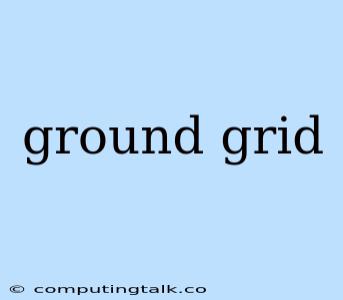A ground grid is a vital component in any electrical system, particularly those exposed to lightning strikes or significant electrical disturbances. It acts as a safety net, preventing electrical surges from causing damage or harm. Understanding the purpose, function, and installation of a ground grid is crucial for ensuring a safe and reliable electrical system.
What is a Ground Grid?
A ground grid is a network of interconnected conductors buried beneath the ground, forming a large conductive surface. This surface acts as a low-resistance path for electrical currents, effectively diverting any surge or fault current away from sensitive equipment and structures. It is essentially a large, buried electrode that provides a safe and reliable grounding point for your electrical system.
Why is a Ground Grid Important?
Ground grids play a critical role in protecting your electrical system and the surrounding environment from several hazards, including:
- Lightning Strikes: When lightning strikes a building or structure, the immense surge of electricity can cause serious damage to electrical equipment, start fires, or even injure people. A ground grid disperses this energy safely into the ground, minimizing the risk of damage.
- Ground Faults: Electrical faults can occur when a live wire comes into contact with ground, creating a path for current to flow to the ground. A ground grid provides a low-resistance path for this current, preventing dangerous voltage buildup and ensuring the safety of people and equipment.
- Electromagnetic Interference (EMI): Electronic devices can be affected by EMI, which can disrupt their operation and cause malfunctions. A ground grid helps to reduce EMI by providing a common ground reference for all electrical components, minimizing interference.
How is a Ground Grid Installed?
Installing a ground grid involves several key steps:
- Planning and Design: The design of a ground grid depends on factors such as the size of the structure, the soil type, and the expected lightning strike frequency. Professional engineers are usually involved in this process.
- Excavation: A trench is dug around the perimeter of the structure to accommodate the conductive wires and connection points. The depth of the trench varies based on the local soil conditions and the specific design requirements.
- Conductor Installation: Copper or galvanized steel conductors, typically in the form of bare wires or cables, are laid out in a grid pattern within the trench. The conductors are connected to each other at regular intervals using specialized connectors or clamps.
- Connection to Ground Rods: Vertical grounding rods, made of copper or steel, are driven into the ground at strategic points. These rods provide a direct connection to the earth and are connected to the ground grid using heavy-duty cables.
- Testing and Verification: Once the ground grid is installed, it needs to be thoroughly tested to ensure its effectiveness. This typically involves measuring the ground resistance using a specialized testing instrument. The ground resistance should be low enough to effectively dissipate any electrical surge.
- Maintenance: Regular inspection and maintenance of the ground grid are essential to ensure its continued effectiveness. Corrosion, damage, or loose connections can significantly reduce its performance and safety.
Types of Ground Grids
Ground grids come in various configurations based on the specific requirements of the installation. Some common types include:
- Rectangular Grid: This is the most common type of ground grid, consisting of a network of conductors arranged in a rectangular pattern.
- Radial Grid: This type of grid uses a central point as a reference and extends radiating conductors outwards.
- Mesh Grid: This design uses a fine mesh of interconnecting wires to create a more extensive conductive surface.
- Circular Grid: This configuration is typically used for smaller structures or equipment, featuring a circular network of conductors.
The choice of ground grid type depends on several factors, including the size and shape of the structure, the soil conditions, and the level of protection required.
Benefits of a Ground Grid
Installing a ground grid offers numerous benefits, including:
- Enhanced Electrical Safety: It provides a low-resistance path for fault currents, minimizing the risk of electrical shocks and ensuring the safety of people.
- Protection from Lightning Damage: A ground grid effectively disperses lightning energy into the ground, minimizing the risk of damage to electrical equipment, structures, and sensitive electronics.
- Reduced Electromagnetic Interference (EMI): It creates a common ground reference, minimizing EMI and ensuring the reliable operation of electronic devices.
- Increased System Reliability: A well-designed and properly installed ground grid enhances the reliability of the electrical system, reducing the risk of outages and malfunctions.
Ground Grid Considerations
While ground grids offer significant protection, several factors must be considered during planning and installation:
- Soil Conductivity: The type of soil can significantly affect the effectiveness of a ground grid. Dry, rocky soils have higher resistance than moist, clay-rich soils. Choosing appropriate grounding rods and spacing based on the soil conditions is crucial.
- Corrosion: Grounding electrodes and conductors can be susceptible to corrosion over time, particularly in harsh environments. Using corrosion-resistant materials and implementing preventive measures can extend the lifespan of the ground grid.
- Maintenance: Regular inspection and maintenance of the ground grid are essential for ensuring its continued effectiveness. Any damage or loose connections should be addressed promptly.
- Professional Expertise: Installing a ground grid requires specialized knowledge and expertise. It is advisable to consult with a qualified electrical engineer to ensure the proper design and installation of a safe and effective system.
Conclusion
A ground grid is an essential safety feature for any electrical system, particularly those exposed to lightning strikes or potential electrical hazards. It provides a low-resistance path for electrical currents, minimizing the risk of damage and ensuring the safety of people and equipment. By understanding the importance, function, and installation of a ground grid, you can contribute to creating a safe and reliable electrical environment. Always consult with a qualified electrical engineer to ensure the proper design and installation of a ground grid that meets your specific requirements.
